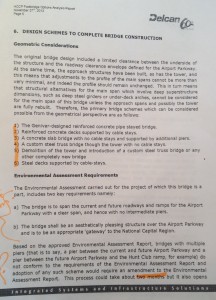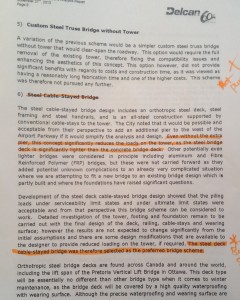The long overdue Airport Parkway Bridge will undergo a transformation this year after safety concerns arose with the original design, according to a report by Delcan engineering firm released by the city.
Delcan’s report, confirms that a steel bridge deck will replace the original concrete platform, which was in the process of being built.
Last fall, engineering firm Genivar was fired by the city because of structural problems in its plan of the bridge. Delcan Corporation was hired to complete the rest of the Airport Parkway Bridge, which will link the Hunt Club community to the South Keys transit station.
Delcan reviewed the partially completed structure and found that there were many deficiencies, including cracks in the concrete tower and in the bridge deck-these are obvious safety concerns.
In the report, obtained through a municipal freedom-of-information request, Delcan says the steel-designed bridge platform will reduce the weight put on the central tower. The cable wires attached from the top of the tower to the bridge deck are expected to be more reliable than the originally planned pipe equivalent.
The firm also notes that if one of the pipe-stays were to break, it “would almost certainly result in the collapse of the bridge.”
At the Finance and Economic Development Committee in March, SEG Management Consultants presented a third-party review of the project and outlined future recommendations.
The review noted a number of issues not only in the original design plans but also regarding the poor communication between staff, elected officials, and the public.
Structural problems during the building of the bridge have caused a three-year delay, making the completion forecast late 2014.
Since 2008, the budget has increased to $11.5 million from $6.5 million.
Last fall, Delcan began a review to recommend a more efficient plan to complete the bridge.
The Delcan report highlights concern for the original Genivar design, which received no further consideration in future plans.
Their report also revealed that the original construction plan violated provincial Environmental Assessment requirements.
Under the Environmental Assessment criteria “the bridge is to span the current and future roadways and ramps for the Airport Parkway with a clear span, and hence with no intermediate piers.”
Because of the proposed addition of a column in the centre of the parkway, the design layout didn’t conform to the required criteria. Adjusting environmental regulations to fit the design could take up to 12 months, so that idea was not pursued.
After assessing various design possibilities, Delcan settled on the steel, cable-supported bridge, instead of the original concrete deck with fixed pipe support.
“The steel cable-stayed bridge design includes an orthotropic steel deck, steel framing and steel handrails, and is an all-steel construction supported by conventional cable-stays to the tower. ”
The existing tower on the East side of the parkway, remnants from Genivar’s work, will be incorporated in the current plan.
For many in Ottawa, this long over-due project has been an embarrassment to the city.
Deputy city manager, Nancy Schepers, has overseen the development of the Airport Parkway Bridge.
She says the city took action during the initial stages of construction when they realized there were issues with Genivar’s design in terms of the “longevity of the structure”.
“Genivar is responsible for their design and we are in litigation with them. We had a stamped engineering drawing that we were working with and as I’ve said to council, we became very concerned,” says Schepers.
Since Delcan’s report has been released, Schepers is optimistic that the date of completion will remain the end of 2014.
“We’re continuing to move ahead with the project as the design is being finalized,” says Schepers.
ATI Requests at each level of government
Previously released ATI requests
Communication between government agencies

This is a report by Delcan engineering firm, which highlights the safety concerns related to Genivar’s original Airport Parkway Bridge design and outlines Delcan’s current design plans. This report was obtained through a municipal freedom-of-information request released by the City of Ottawa. This information was useful because it shows that the previous bridge design by Genivar violated the provincial Environmental Assessment Requirements. It also states that the new bridge proposal will take these conditions into consideration by omitting a centre pier.

This is a report by Delcan engineering firm, which highlights the safety concerns related to Genivar’s original Airport Parkway Bridge design and outlines Delcan’s current design plans. This report was obtained through a municipal freedom-of-information request released by the City of Ottawa. This information was helpful because it explains Delcan’s decision to replace the concrete bridge platform with a lighter steel bridge deck. It also underlines why the cable wire support is more reliable than the pipe equivalent. Ultimately, it describes the details of the chosen design plan for the Airport Parkway Bridge.






